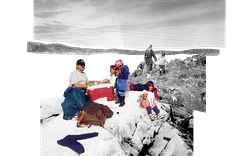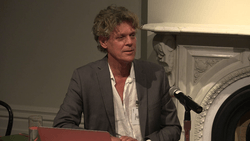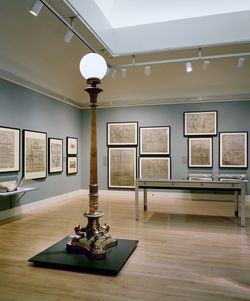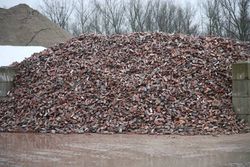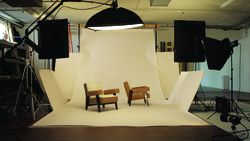drawings, textual records
ARCH172233
Description:
Ce groupe contient aussi des notes et croquis pour les projets Coopérative Fraternité (projet non-réaliasé, une construction de logements collectifs coopératifs, 1983), et Cape Van Horne (projet non-réalisé, le recyclage d'un édifice et aménagement d'un restaurant, 1983).
Notes préliminaires et croquis
Actions:
ARCH172233
Description:
Ce groupe contient aussi des notes et croquis pour les projets Coopérative Fraternité (projet non-réaliasé, une construction de logements collectifs coopératifs, 1983), et Cape Van Horne (projet non-réalisé, le recyclage d'un édifice et aménagement d'un restaurant, 1983).
drawings, textual records
articles
Futurecasting: Towards Indigenous-Led Architecture
Nicole Luke speaks to Rafico Ruiz and Ella den Elzen about collaboration, collectivity, and listening in the future of Indigenous design
Actions:
Antoni Folkers discusses a collection related to modern architecture in Africa that was recently acquired by the CCA. His account traces the activity of three travellers involved in building the collection: Georg Lippsmeier in the 1950s, Coen Beeker in the 1960s, and Kiran Mukerji in the 1970s. An architect and urban designer, Folkers is the author of Modern Architecture(...)
Shaughnessy House
14 July 2016, 6pm
Antoni Folkers: Modern Architecture in Africa
Actions:
Description:
Antoni Folkers discusses a collection related to modern architecture in Africa that was recently acquired by the CCA. His account traces the activity of three travellers involved in building the collection: Georg Lippsmeier in the 1950s, Coen Beeker in the 1960s, and Kiran Mukerji in the 1970s. An architect and urban designer, Folkers is the author of Modern Architecture(...)
Shaughnessy House
Mapping Rural Montréal
On a tour of downtown Montréal, San Francisco-based artist Amy Franceschini shows participants ‘rural’ sites and activities and questions the dichotomy of country and city. Franceschini founded Futurefarmers, a collaborative and experimental studio that addresses ecological issues, as well as the online magazine, Atlas. Inspired by the exhibition Actions: What You Can Do(...)
4 April 2009
Mapping Rural Montréal
Actions:
Description:
On a tour of downtown Montréal, San Francisco-based artist Amy Franceschini shows participants ‘rural’ sites and activities and questions the dichotomy of country and city. Franceschini founded Futurefarmers, a collaborative and experimental studio that addresses ecological issues, as well as the online magazine, Atlas. Inspired by the exhibition Actions: What You Can Do(...)
articles
Building a Forest
Forces of Friction
Project
AP066.S3.D12
Description:
Le dossier documente le concours sur invitation de la Faculté de l'aménagement de l'Université de Montréal tenu en 1994, de septembre à novembre. Le dossier contient des dessins, des reprographies, une maquette et des documents textuels. Objectifs du concours: "C'est avec une grande confiance que nous misons sur l'excellence des propositions que les équipes soumettront: l'objectif poursuivi est de doter la Faculté d'aménagement, après plusieurs années d'attente, d'espaces d'une qualité correspondant aux enseignements qu'elle dispense et d'un lieu qui puisse devenir une référence en matière d'aménagement." Extrait de la lettre du Doyen de la Faculté et de la directrice de Immeubles aux concurrents (66-C012-002T). Description du projet par l'architecte: "L'implantation d'une figure d'exception telle le cercle pour l'agrandissement du pavillon (qui comporte les fonctions à caractère collectif du programme) réussit à instaurer une polysémie très riche sur les plans urbain et architectural par ses références historiques et formelles conjuguées aux visions ouvertes des espaces contemporains. Aussi, au niveau du paysage, la figure d'exception introduit le thème du pavillon du parc pour se transfigurer comme objet et enluminure au coeur du paysage." Extrait d'une lettre de l'équipe de Jacques Rousseau au jury, accompagnant la soumission du projet (66-C012-002T).
1993-1994
Concours de la Faculté de l'aménagement de l'Université de Montréal
Actions:
AP066.S3.D12
Description:
Le dossier documente le concours sur invitation de la Faculté de l'aménagement de l'Université de Montréal tenu en 1994, de septembre à novembre. Le dossier contient des dessins, des reprographies, une maquette et des documents textuels. Objectifs du concours: "C'est avec une grande confiance que nous misons sur l'excellence des propositions que les équipes soumettront: l'objectif poursuivi est de doter la Faculté d'aménagement, après plusieurs années d'attente, d'espaces d'une qualité correspondant aux enseignements qu'elle dispense et d'un lieu qui puisse devenir une référence en matière d'aménagement." Extrait de la lettre du Doyen de la Faculté et de la directrice de Immeubles aux concurrents (66-C012-002T). Description du projet par l'architecte: "L'implantation d'une figure d'exception telle le cercle pour l'agrandissement du pavillon (qui comporte les fonctions à caractère collectif du programme) réussit à instaurer une polysémie très riche sur les plans urbain et architectural par ses références historiques et formelles conjuguées aux visions ouvertes des espaces contemporains. Aussi, au niveau du paysage, la figure d'exception introduit le thème du pavillon du parc pour se transfigurer comme objet et enluminure au coeur du paysage." Extrait d'une lettre de l'équipe de Jacques Rousseau au jury, accompagnant la soumission du projet (66-C012-002T).
Dossier 12
1993-1994
This exhibition looks at the transformation of Montréal from a nineteenth century merchant city to the metropolis of Canada. It examines the elements that made Montréal a political, social, and economic centre and explores the unique character of its architecture. The exhibition brings together some 350 objects, including drawings from the CCA collection by Montréal(...)
Main galleries
18 March 1998 to 24 May 1998
Montréal Métropole, 1880–1930
Actions:
Description:
This exhibition looks at the transformation of Montréal from a nineteenth century merchant city to the metropolis of Canada. It examines the elements that made Montréal a political, social, and economic centre and explores the unique character of its architecture. The exhibition brings together some 350 objects, including drawings from the CCA collection by Montréal(...)
Main galleries
Learning from... Brussels
Rotor members Michael Ghyoot and Maarten Gielen investigate the processes and practices of material management in Brussels and its suburbs. The concept of waste played a key role in their research and was informed by hundreds of visits to businesses, work sites, and recycling plants. The examination of discarded, unfinished products or those considered of inferior quality(...)
Paul Desmarais Theatre
19 April 2012 , 7pm
Learning from... Brussels
Actions:
Description:
Rotor members Michael Ghyoot and Maarten Gielen investigate the processes and practices of material management in Brussels and its suburbs. The concept of waste played a key role in their research and was informed by hundreds of visits to businesses, work sites, and recycling plants. The examination of discarded, unfinished products or those considered of inferior quality(...)
Paul Desmarais Theatre
American artist Amie Siegel’s moving image work Provenance (2013) follows the global trade of furniture from Chandigarh in reverse: from the homes of collectors in Europe and North America to sale at auction, restoration, through overseas transport and finally back to India. Originally designed by Le Corbusier and Pierre Jeanneret, the Chandigarh furniture now sells(...)
24 April 2014 , 6pm
Artist’s Talk: Amie Siegel, Provenance
Actions:
Description:
American artist Amie Siegel’s moving image work Provenance (2013) follows the global trade of furniture from Chandigarh in reverse: from the homes of collectors in Europe and North America to sale at auction, restoration, through overseas transport and finally back to India. Originally designed by Le Corbusier and Pierre Jeanneret, the Chandigarh furniture now sells(...)
archives
Level of archival description:
Fonds
Robert Duchesnay fonds
AP115
Synopsis:
Le Fonds Robert Duchesnay consiste en une série de photographies montrant les divers structure (principalement des dômes géodésiques) conçus ou influencée par R. Buckminster Fuller. Les photographies, prises par l'artiste et photographe montréalais Robert Duchesnay, ont été créées entre 1985 et 1992.
1985-1992
Robert Duchesnay fonds
Actions:
AP115
Synopsis:
Le Fonds Robert Duchesnay consiste en une série de photographies montrant les divers structure (principalement des dômes géodésiques) conçus ou influencée par R. Buckminster Fuller. Les photographies, prises par l'artiste et photographe montréalais Robert Duchesnay, ont été créées entre 1985 et 1992.
archives
Level of archival description:
Fonds
1985-1992
